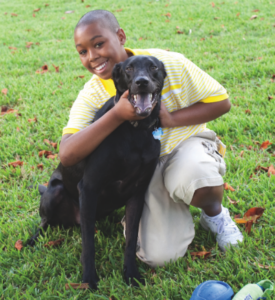
Animal Adoption
By Kim Seidel
Our family’s rollercoaster adventure into pet adoption started two years ago, when our two daughters wanted to dress up as Humane Society volunteers for Halloween. I felt impressed by their creativity at ages five and nine, but I wasn’t surprised because they love animals, and we didn’t own a pet.
Two years and several visits to a local humane society later, we adopted, surrendered and re-adopted the same dog. It’s still heartbreaking to recall the process we experienced, but we learned many valuable lessons.
Though enthusiastic about adopting a pet, we were uncertain about the dramatic changes a two-year-old, energetic black lab/border collie mix would bring to our home.
Our first night with 50-pound Manni proved disastrous. In her excitement, our new dog spent the first hour jumping on furniture and running from room to room. We nervously watched, unsure how to handle her as the dog expert―my husband―worked late.
The girls and I decided to take her for a walk, mistakenly thinking exercise would be a calming remedy. A first-time dog owner, I found Manni walking me, dragging me down the sidewalk and pulling my arms in all directions. My daughters tried to jog along, as Manni attempted to chase birds, squirrels, other canines, cars and anything else that moved.
After our walk-run, Manni literally threw up from over-excitement in front of the girls. In frustration, we stayed in my bedroom, held hostage as the dog ran around, until my husband returned to our rescue.
The next morning, I felt angry and wanted to return Manni. My husband and youngest asked me to make the decision. My oldest felt devastated when I took her back like I was returning a blouse that didn’t fit. “My worst nightmare has come true!” she cried. She had a pet one day, and the next day her dog was gone.
But our story has a happy ending: Today we’re proud owners of Manni. She has brought us lots of challenges, but she has also brought us plenty of joy.
Your family can avoid pet “nightmares” and become successful pet owners by following some basic guidelines from the humane society and learning from others along the way.
Consider your family’s lifestyle
The most important factor to think about is your family’s lifestyle. This takes careful thought and honesty that benefits animals and families.
Many people go to an animal shelter or a pet store, and they have an idea in their head about what they want to adopt. Yet, their idea may be appropriate to their situation, or it may not. Use an open mind when looking for a pet.
During the adoption process at most humane societies, potential owners are required to spend time with an adoption counselor and the animal they’re interested in. The potential adopters complete an application with a staff member. This can be a hurdle for some families, and some people may find it intrusive. Keep in mind that the humane society wants to get to know a person before letting them take a pet home to make sure it’s a good match.
Answering the lifestyle questions is especially important. For example, our family is active, so we thought Manni would be an excellent companion for walking and hiking. We didn’t realize Manni’s deep pool of energy, and the immense time and effort required to properly train her.
If you’re serious about pet adoption, research a breed’s general personality and nature and think about how the animal would fit into your family’s life.
In some cases, a cat provides a better match than a dog for families working long hours or going away frequently. Many humane societies also offer small animals—birds, rats, guinea pigs and even fish—for adoption. Upon arrival to the shelter, all animals are carefully observed to ensure they’re adoptable.
Children are a huge factor in the lifestyle equation. Humane societies can determine if a particular pet would fit the ages of your children. Humane societies want to work with you and your family to find a good match. If they don’t, the animal and your family will be at a disadvantage.
Other lifestyle factors to consider include: your dwelling (whether your home or apartment is fitting for a particular pet); health (whether any family members have allergies or other considerations); and other household pets (whether a new pet will get along with your other animals).
Know the money/time commitment
The first few weeks with a new pet is “the honeymoon period.” It’s pure excitement then, but people forget that the pet will continue to always need something—obedience training, attention, feeding and so much more.
A nominal fee is paid for the adoption, which covers food, medications and other costs. With each adoption, the adopter signs a contract stating that he/she will spay/neuter and license the animal, as well as provide vaccinations and veterinary care.
When you adopt a pet, you’re making a huge decision about your time and cash. Dogs and cats can live as long as 15 to 17 years. That’s a lengthy period, so it’s important to think beyond the short-term excitement to the long-term commitment.
There’s no way around it—pets cost money. With supplies, food and basic veterinary care, dogs can run about $500 to $600 a year, and cats cost $350 to $500. The first year is the most expensive, as you purchase basic supplies, and pay for veterinary care to maintain your pet’s health.
Get organized
After I returned Manni to the humane society, an education director took Manni into her home as a “foster mom.” She shared insight into Manni’s personality and advised us to give her a lot of exercise. “A tired dog is a happy dog,” has become our family motto.
Before we re-adopted Manni, we took more time to plan for our purchases and re-evaluated how we would handle her energetic personality. My husband and I created a weekly schedule for Manni’s walks and trips to the dog park to make sure she gets regular, extensive exercise.
Train your pet
As a family, we also took Manni through a basic obedience class with a certified professional dog trainer and animal behavior specialist. Several organizations offer classes for all ages and stages at little or no cost. I highly recommend these courses as a way to learn more about your pet and how to better manage their behaviors in loving and effective ways. Just like parenting, we dedicate ourselves every day to guide and protect our pet.
Seek support
Take advantage of friends who can offer support, advice and information about owning a pet.
Volunteer or foster
Volunteering at your local humane society is an excellent way to become acquainted with furry friends. Volunteers can walk, play, groom, bathe and spend time with animals. Fostering a pet for a period of time is also a great way to see if your family is ready to permanently adopt an animal. Your children can get a head start on loving and caring about our animal friends.





